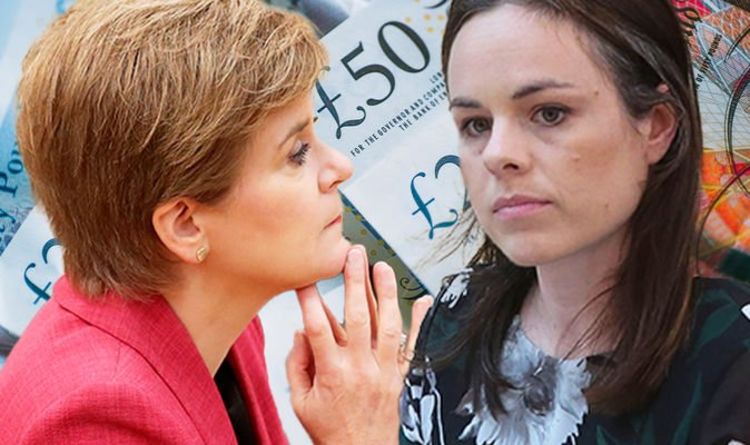SNP: Derek Mackay proposes transition to Scottish currency
We use your sign-up to provide content in ways you’ve consented to and to improve our understanding of you. This may include adverts from us and 3rd parties based on our understanding. You can unsubscribe at any time. More info
Two studies released by the Institute for Government (IfG) today also said a separated Scotland would find it more expensive to borrow than UK Government counterparts due to a lack of track record in international markets. In a hammer blow to Nicola Sturgeon’s independence plans, economists said an independent Scotland would therefore need to raise taxes or have lower government spending.
At last year’s SNP conference, the Nationalists voted to replace the pound with a separate Scottish currency “as soon as practicable”.
The decision at the 2020 party conference last year was a major change to the party’s stance in the 2014 independence referendum.
At the time, former First Minister of Scotland Alex Salmond said an independent Scotland would continue to use the pound in a formal UK-wide currency union.
But in the report, published today, IfG economists warn a formal currency union with the rest of the UK is not “viable” – nor is joining the Euro in the event of Scotland entering the EU.
Suggestions that “pegging” a new Scottish currency to the value of another were also dismissed.


The report suggested two other viable options but economists stressed they still had risks associated with them.
SNP ministers could introduce a new currency that floats freely on foreign exchange markets and would give Scotland more freedom and control over monetary policy.
However, its value would be “volatile” and make it harder for Scotland to trade, the report said.
Economists also indicated Scotland could have an “informal” currency union with the UK, where Scotland continues to use the pound but would leave monetary policy to be set by the Bank of England.
This would leave Scotland unable to print money and unable to engage in quantitative easing, as Deputy First Minister John Swinney admitted earlier this week.
READ MORE: Boris faces Supreme Court battle over hated EU deal

The reports also suggest Scotland’s ability to borrow would be restricted by what international investors were willing to lend regardless of its currency decision.
It also noted the national deficit before COVID-19 – the gap between public spending and income of £15.8billion (8.8 per cent of GDP) – was one of the highest in the developed world.
It makes clear no “advanced economy – especially no small, advanced economy – has consistently borrowed anything like that much in normal times.”
IfG economists suggest a sustainable deficit would be closer to three percent but made clear an independent Scotland would still pay higher interest on its debt than the UK does.
The report also noted an independent Scotland’s tax base “would be more volatile than the UK’s due to its greater reliance on oil and financial services.”
DON’T MISS:
UK to launch rockets from Spaceport after Danish legal challenge [INSIGHT]
Fury as SNP Health Secretary tells Scots to ‘think twice’ before call [REVEAL]
EU blasted over City of London ‘power grab’ over financial services [LATEST]

Ministers would therefore need to spend more on debt interest, requiring lower spending elsewhere or higher taxes.
Gemma Tetlow, chief economist at the Institute for Government, said: “Scotland’s currency choice would have far wider implications than just the cash people use in their day-to-day lives – including implications for financial stability, what freedom the government has to use monetary and fiscal policy, how easily businesses can trade with other countries, and the attractiveness of Scotland to foreign investors.
“There is no single best choice, all options would come with trade-offs.”
Liz Smith MSP, Scottish Conservative Shadow Finance and Economy spokesperson, said: “The conclusions contained in the IFG report are entirely accurate and they only increase the concerns about the economic costs of independence.
“The SNP has never provided clarity about what new currency would be used in an independent Scotland nor has it ever acknowledged the additional debt and borrowing costs that would accompany it.
“The economic case for independence has always been inherently weak.
“This report just confirms that and why the attention of the Scottish Government should be on economic recovery from the pandemic and not on preparation for a second independence referendum.”
John Swinney: Scotland to have more powers with own currency
Pamela Nash, chief executive of Scotland in Union, said: “This exposes the astonishing risk and recklessness of the SNP’s plan to scrap the pound.
“Introducing a new Scottish currency would have devastating consequences for our economy, with a knock-on impact on how much we can spend on hospitals, schools and social care services.
“When our NHS is in crisis and people are waiting hours for ambulances, and we have years of recovery ahead of us following Covid, this proves just how irresponsible the SNP’s separation blueprint really is.
“Rather than gamble with people’s futures, the best future for Scotland is as part of the UK so that we can keep the pound and bring people together to build a recovery for everyone.”
It comes just weeks after Government figures revealed Scottish public spending topped £99billion in the first year of the pandemic – £36billion more than was raised in taxes.
The Government Expenditure and Revenue Scotland (GERS) report also found the national deficit increased to £36.3billion in 2020/21.
But Alison Thewliss MP, SNP Shadow Chancellor, said: “To imply that Scotland is virtually the only developed economy in the world for which there is no good or viable currency option is a ludicrous suggestion which no one can or should take seriously.
“Scotland has a fundamentally strong economy but we need the full fiscal and borrowing powers which only independence can deliver to secure a fair and sustainable recovery.”
Source: Read Full Article
